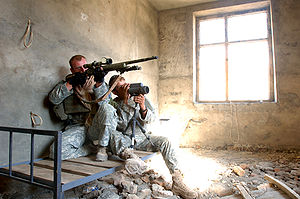This article needs additional citations for verification. (June 2019) |
A hunter-killer team is a team that separates the tasks of "hunting" and "killing" to two or more individuals.

Examples include:
- Two-person sniper teams, one using specialized optical hardware and the other a rifle
- Pairs of F-4G Wild Weasel V and F-16Cs, where the F-4G "hunter" could detect, identify, and locate an enemy's radar and then direct the F-16C's weapons to the site
- Bradley fighting vehicles may "hand off" fire missions to M1 Abrams main battle tanks in their hunter-killer team, but Bradley’s have TOWs and can engage
- "Pink teams" of scout and attack helicopters, such as OH-6 "Loach" or OH-58 Kiowa scout helicopters and the AH-1 Cobra attack helicopter during the Vietnam War
- In anti-submarine warfare an Maritime patrol aircraft may be employed as "hunter", with surface ships such as destroyers as killers.
- Task Forces such as Task Force 88 where one element, the "hunter," (e.g., CIA Operatives) gathers intelligence on the target while the other, the "killer," (e.g., Delta Force or Rangers) acts on the intelligence and eliminates the target.
Operations edit
Hunter killer operations are prolonged operations conducted in irregular warfare by a unique and specifically organized force, in conjunction with an indigenous force, against irregular warfare adversaries by operating behind the lines or in hostile, safe haven, or semi permissive environments, employing unorthodox tactics, for the sole purpose of achieving attrition and punitive actions predominantly against the personnel, leadership, and resources of the enemy.[1]
Principles edit
Hunter-killer forces and operations:
- are best employed during irregular warfare environments[2]
- require independent maneuver in enemy territory[2]
- should not be formed ad hoc[3]
- require specialized training in enemy tactics and weaponry, long-range endurance operations, infiltration and exfiltration techniques, and combat techniques[4]
- require equal or superior maneuverability and mobility to the enemy in order to succeed[4]
Advantages edit
The hunter-killer approach provides:
- versatility through its combination of combat power, reconnaissance capability, and survivability.[5]
- the ability to effectively acquire information aggressively, perform security, and conduct counter-reconnaissance.[5]
- control of any predicament the team is in, and of the operational tempo, denying this to the enemy.[6]
- psychological effects on the enemy, specifically their will to fight.[6]
References edit
- ^ Celeski, Joseph D. (January 2010). Hunter-Killer Teams: Attacking Enemy Safe Havens. Florida: Joint Special Operation University. p. 7. ISBN 978-1-933749-43-3.
- ^ a b Celeski, Joseph D. (January 2010). Hunter-Killer Teams: Attacking Enemy Safe Havens. Florida: Joint Special Operation University. p. 52. ISBN 978-1-933749-43-3.
- ^ Celeski, Joseph D. (January 2010). Hunter-Killer Teams: Attacking Enemy Safe Havens. Florida: Joint Special Operation University. p. 53. ISBN 978-1-933749-43-3.
- ^ a b Celeski, Joseph D. (January 2010). Hunter-Killer Teams: Attacking Enemy Safe Havens. Florida: Joint Special Operation University. p. 54. ISBN 978-1-933749-43-3.
- ^ a b Leadership, The Stable of (2018-02-04). "BlackJack Self Study Program #7: Hunter-Killer Teams". Medium. Retrieved 2019-05-07.
- ^ a b Celeski, Joseph D. (January 2010). Hunter-Killer Teams: Attacking Enemy Safe Havens. Florida: Joint Special Operation University. p. 2. ISBN 978-1-933749-43-3.